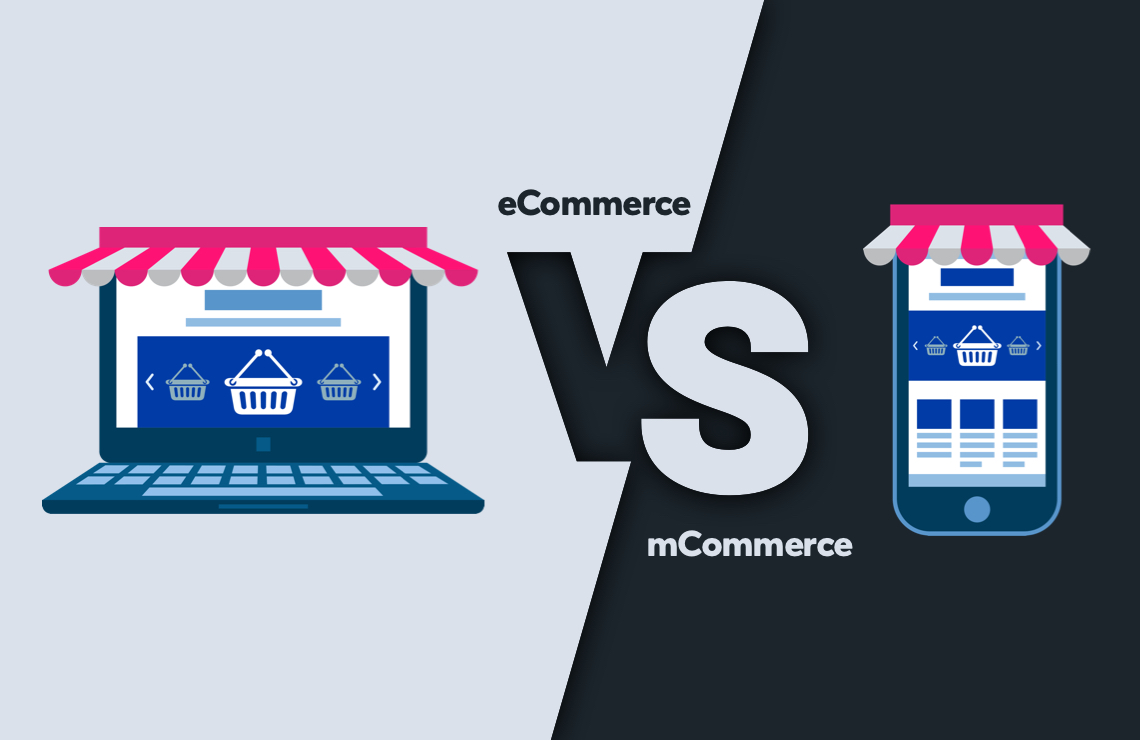mCommerce revolution in 2019
Recently, mobile shopping is reaching new heights. As it’s known, mobile technology is advancing rapidly. Therefore, more and more customers are turning to their mobile devices when it comes to online shopping.
Mobile commerce (or shortly, mCommerce) is widely mentioned as one of the most popular eCommerce trends in 2019. There are many facts and statistics that prove that mCommerce is the next step in the evolution of eCommerce.
To ensure you don’t fall behind on this trend, our first and foremost recommendations are to optimize your website and develop an eCommerce app.
We have highlighted a few statistics that you will surely find interesting and helpful:
- Americans spent more than 3.5 hours on their mobile device per day in 2018
- 93% of millennials compared online deals using their mobile device in 2018
- The global mobile coupons industry is expected to grow by 56.5% by 2025
Mobile commerce is swiftly taking over the online shopping industry and it’s going to evolve even faster. In this article, you will find about how you can jump on this trend and evolve your business. We have carefully curated the information on this topic and you will surely find it beneficient.
<[book id='10224']>
What is mCommerce?
Mobile commerce or widely known, mCommerce refers to the use of wireless handheld devices to conduct commercial transactions online, also including the purchase and sale of products, online banking, and bill payments.
The term “mobile commerce” was forged long ago, in 1997, at the launch of the Global Mobile Commerce Forum. His exact words were “the delivery of electronic commerce capabilities directly into the consumer’s hand, anywhere, via wireless technology. Many choose to think of Mobile Commerce as meaning ‘a retail outlet in your customer’s pocket.”
The rapid growth of mCommerce is supported by many factors, including better performances of mobile devices, broad solutions of security issues and currently trending digitalization of everyday life in general.
Mobile commerce is becoming more and more convenient. Especially due to digital wallets like Apple Pay and Android Pay that let customers make in-store purchases without the inconvenience of bringing any physical cards.

Also, a few years ago, social media platforms like Facebook, Twitter, Pinterest, and Instagram have added the “buy button” on their mobile platforms which enable users to make purchases directly through their platform, making mobile shopping even more convenient.
Customers usually use Google and/or social media to initiate an online shopping search. Therefore, browsers tend to drive more transactions than mobile applications. For this reason, most of the customers use both mobile applications and mobile websites to enhance their shopping experience. This is more than enough reason to optimize your website for mobile usage and increase sales through mobile apps.
Further on, to drive more customers to your mobile application, there are some changes that are crucial to implement. For instance, loyalty programs are very much needed to retain customers and to increase the lifetime value of the customers. They will feel respected and happy that they are getting more out of the product than the rest of them.
There are also more ways to create a successful eCommerce app. It needs to have a flow. You need to get into customers’ minds and locate their pain points so you can eradicate them. And lastly, you need to have a perfect solution, something they can relate to and both of you should come out as the winners in the trade. It’s always a win-win situation.
Mobile commerce is currently peaking and to increase your maximum revenue, you should definitely consider creating your eCommerce mobile app and get the best out of both worlds, both application and website.
Impact of mobile shopping
E-commerce is on the rise globally. Companies without physical stores are making waves in business from utilizing the potential of the internet.
To get more information on eCommerce in general, we have handpicked the top 10 eCommerce blogs that will provide you with many useful tips on how to shine in the crowded market.
On our blog, we’ve pointed out why retail businesses need to have a mobile app. It’s a must-have in this wave of mobile revolution where everything is done via mobile phones.
It would, therefore, be ludicrous for a business to expect that they could continue to maintain their competitiveness while ignoring the influence mobile has on how their customers use and consume information from the internet.
The reality is that one should not regard the adaptation of mCommerce with a bandwagon approach. You do not just go into mobile commerce because other businesses have ventured into it. You should go into mobile commerce because it’s the next level of eCommerce.
To bring you closer to understanding the real power of mCommerce, we have highlighted the most astonishing statistics:
49% of consumers use mobile phones for shopping
Last year, BrizFeel published a piece on consumers’ online shopping behavior and spending habits. In addition to closely observing the current state of the e-retail world, the source also provided us with insights about preferred platforms for shopping.
According to BrizFeel, 49% of consumers use mobile phones for shopping online, while a somewhat lower percentage shop via PCs. Tablet users are not all that active when it comes to online shopping, as, according to the source, only 8% of consumers use tablets for online shopping.
In 2018, Cyber Monday mobile sales generated over $2 billion
For the first time in Cyber Monday history, this happened. Mobile users accounted for more than half of all website traffic, to be exact – 51.4%. Unbelievably huge numbers. Revenue of $2 billion set a new record for Cyber Monday and judging by all facts and statistics, this year is also going to be a record one.
39% of all internet users prefer mobile payments
According to Statista, mobile payments have been widely adopted. Based on all the answers, more than a third of all internet users prefer mobile payments. Especially in China, where 64% of users say that they prefer mobile payments to other payment methods.
61% of US consumers use their mobile devices in stores to compare prices.
As it’s featured on Statista, US consumers use their mobile devices while shopping in retail stores. They do it for various reasons. 61% of consumers compare prices while in store, and 63% of them use mobile app coupons for in-store purchases. Additionally, 56% of customers use their mobile devices to review store inventories.
Smartphones are the leading mCommerce device for shopping.
Based on the results of the Scandit Retail Consumer survey from 2018, 83% of customers use shopping apps on their mobile devices. Tablet users use it rarely, only 14% of them. The percentage of customers using shopping apps on wearable devices is still only 3%.
Additionally, 43% of smartphone owners rate online shopping as one of their top activities. It’s also a top activity among tablet owners too. They are less active regarding this, with only 17% of customers using tablets for online shopping. Merchant Savvy gathered more mCommerce statistics so feel free to check it out!
As presented above, mobile shopping and mCommerce, in general, are making a huge push in taking over the eCommerce world. It’s quickly gaining momentum and the customers are fully aware of it.
mCommerce vs. eCommerce

Even though mCommerce and eCommerce have different meanings, they both have the same aim – to make their customers’ lives easier. It’s possible to compare them by saying that eCommerce is a term for selling and buying online and that mCommerce is a term for selling and buying via mobile devices.
They have many similarities and differences even though they have the same goal. There are several key differences. Mobile commerce is the next step in the evolution of eCommerce; therefore it’s more advanced in some aspects than eCommerce, but first, let’s highlight the differences:
1. Mobility

Ecommerce stands for electronic commerce. Hence, shopping is done on the internet. Typically, all eCommerce activities are made with the help of desktop computers or laptops.
On the other hand, mCommerce implies using mobile devices. Customers can make transactions on the move, as long as they have an internet connection. Instead of using physical cards, mobile wallets like Apple Pay enable users to complete any transaction on the go.
2. Location

Due to the non-portability of devices, such as laptops and desktop computers, location tracking capabilities of eCommerce are limited.
On the other hand, location tracking capabilities of mCommerce are barely limited. Mobile applications can track and identify users with the help of GPS, Wi-Fi, etc. Mobile commerce applications can provide personalized content based on location and personal interests.
In that way, local businesses can target their customers through personalized promotional offers and get the most out of their advertising.
The push notifications make it even easier in contacting your customers. They somewhat eradicate the need for e-mailing your existing customers and enable you to quickly notify them of your promotions and special discounts,
3. Security

Security stands as one of the crucial components of any online transaction. In the eCommerce, standard practice is the usage of physical credit cards. Many customers are still worried about their security regarding this and tend to hesitate to fill out their credit card information.
Nevertheless, the security capabilities of mCommerce have reached a new level. While there are still some standard security measures like two-step authentification and multi-level authentification, mCommerce provides its users with biometric authentification measures, such as face ID, retina scan, fingerprint, and so on.
In each of these three segments, mCommerce comes out as the winner. This is merely a signal for businesses that they need to optimize their websites for mobile users and maximize their revenue.
Importance of optimizing your website for mobile users
There are several reasons why your website should be optimized for mobile users. By now, you already know that it’s common sense, in a way. In 2019, mobile users are taking over the market.
The choice is yours.
Will you let your competition lead the market or will that be you?
To highlight even more on why do you need to optimize your website for mobile users, we have brought more crucial info upon you.
Improved user experience
We’ve all gone through this situation. A friend sends you a link, you open it and there it is – a huge load of unorganized content, almost impossible to navigate. Did that turn you from a visitor to a customer? No.
If a visitor can’t easily browse through the content on your website, they will leave and probably never come back. You don’t want that to happen. Neil Patel has highlighted some statistics that show that 60% of mobile customers in 2018 encountered this kind of problem and left the website.
Increase average time on site
It’s all about time. You have a limited amount of time to capture the visitors’ attention. One of the main reasons for that is that they are always on the go. If your website and content are optimized for mobile users and they can easily navigate, it’s a clear win situation. Chances of converting those visitors into customers increase.
Faster loading speed
Speed is important because as we said, you have a limited amount of time. Unoptimized website will render slowly, or maybe it will not render at all. Optimized websites will usually load for 2-5 seconds and for every second more, the bounce rate gets higher – and you don’t want that.
To present you with some proof, Neil Patel delivers some statistics that show that users abandon a website if they wait more than 6-10 seconds.
Better Mobile SEO
When it comes to SEO, we all follow Google rules, whether we want it or not. And according to Google, it’s recommended that all websites are responsive or mobile-friendly. Having that kind of website immediately increases the probability of your site ranking higher on Google search results.
Mobile commerce is advancing rapidly and it’s vital to keep up with it!
Optimizing your website for mobile and developing eCommerce mobile apps? Go for it!
This is how you can progress in today’s’ hypercompetitive market and establish long-lasting relationships with your customers.
Also, to even better your SEO and optimize your website even further, don’t miss out on voice search optimization! It’s one of the newest trends in eCommerce and it’s coming really fast. Technology is advancing unbelievably fast and it’s crucial to keep up with the advancements.
Customers’ behavior is constantly changing. They are used to convenience and pleasant website visits.
Think about what else can you do to make your customers’ journey even easier. Consider yourself as a sage or a prophet, guiding your hero, the customer, through perilous online journeys. They will encounter many problems and they will turn to you when they need a solution. If you do well, they will spread the word.
Are you ready now to become the hero’s assistant and make his quest easier for him?
Optimize your website and eCommerce app and conquer the market!






